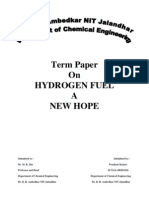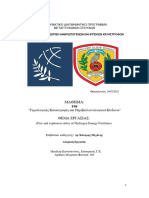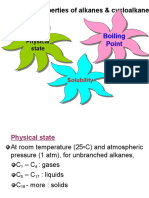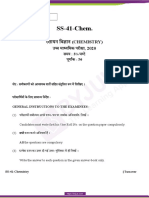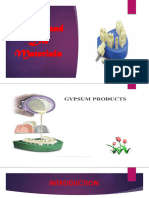0 ratings0% found this document useful (0 votes)
3 viewsLect #11
The lecture discusses hydrogen as a fuel, covering its properties, production methods, and safety issues. Hydrogen is abundant and can be produced through various processes, including thermal, electrical, and biological methods. The document also highlights the challenges of hydrogen storage and its potential role in a future hydrogen economy.
Uploaded by
anhtri.journalCopyright
© © All Rights Reserved
Available Formats
Download as PDF, TXT or read online on Scribd
0 ratings0% found this document useful (0 votes)
3 viewsLect #11
The lecture discusses hydrogen as a fuel, covering its properties, production methods, and safety issues. Hydrogen is abundant and can be produced through various processes, including thermal, electrical, and biological methods. The document also highlights the challenges of hydrogen storage and its potential role in a future hydrogen economy.
Uploaded by
anhtri.journalCopyright
© © All Rights Reserved
Available Formats
Download as PDF, TXT or read online on Scribd
You are on page 1/ 37
Lecture # 11 Hydrogen energy
what is hydrogen? why hydrogen?
hydrogen as a fuel - properties and bottlenecks
production, storage and use of hydrogen
case: solar hydrogen
C6370 Peter Lund 2017
What is hydrogen (H) ?
• A hydrogen atom = 1 p+ + 1 e-
(0 n=prototium, 1 n=deuterium, 2n=tritium)
– mp = 1800 me
– Rorbit ~ 105 Rnucleus
• Quantum mechanics (Schrödinger) of H
explains well its physics and chemistry
[h/2µ∇2 – e2/r] Ψ(r)= E Ψ(r)
Wave function Ψ(r,θ,φ)=R(r)P(θ)F(φ)
– R,P,F quantum numbers
– r,θ,φ coordinates, µ= effective mass
Potential energy U(r)=-e2/4πε0
• Hydrogen makes 75% of all visible mass of
the universe, > 99% of all materia
C6370 Peter Lund 2017
What is a hydrogen molecule (H2) ?
• A single nucleus-electron system is highly
reactive à H forms a molecule with a
hydrogen-hydrogen bond
– Covalent bond, electron wave functions
overlap (4.5 eV)
• H2 can be either in ortho or para form
(proton spin directions)
– Ortho-para ratio= 1+1/I, H2:I=1/2
– H2 (gas): 75% ortho and 25% para
– H2 (liq, 20 K): 0.2% ortho and 99.8% para
– Heat release in ortho-para conversion 0.146
kWh/kg (cf heat of liquefaction 0.123)
C6370 Peter Lund 2017
Energy release (with H2)
– reconfiguring bonds
• Atoms are connected through bonds that lower their total energy
• Bond is formed à energy is released
• Bond is broken à energy is absorbed
• Net release of energy if energy released > energy absorbed
C6370 Peter Lund 2017
Simple hydrogen combustion reaction
• Basic combustion equation: H2 + ½ O2 H2O + 286 kJ/mol
– Collision of molecules à O2 and H2 bonds break à New H2O bonds formed
à Energy of new conhiguration lower à Heat released
• Reconhiguration of bonds in a chemical reaction involves electron transfer
– thermal combustion: very fast electron transfer (picoseconds)
– electrochemical combustion (fuel cells): separating reactants slows down e-
transfer from fuel species to oxidant species
C6370 Peter Lund 2017
Hydrogen as a gas
• Hydrogen follows the ideal gas law
at low pressure
• At higher pressures, gas occupies
less space then IGL predicts
– With compressibility or non-
ideality factor Z=Z(p)
à P = Z ρ R T, ρ = gas density
C6370 Peter Lund 2017
Basic macroscopic properties of
hydrogen as a fuel
• Boiling point at 20 K
• Density 1 m3 hydrogen gas
0.09 (20 oC) . . . liquid 71 kg
(-252 oC)
• Heating value 120-142 kJ/kg
or 33.3 – 39.4 kWh/kg (gas
3-3.6 kWh/m3n)
• High octane number (130)
C6370 Peter Lund 2017
Hydrogen explodes...but
In the LZ 129 Hindenburg disaster, 2/3 of passengers and
crew survived. The skin of the Hindenburg may have
contributed to the actual blaze. Of the 62 passengers, 27
died. Of the 27 dead, 25 jumped to their deaths from the
stricken airship in panic. The other 2 that died did so due
to the fire spreading to the diesel powered engines. The
hydrogen combusKon itself was above, and mostly away
from the gondola.
C6370 Peter Lund 2017
Safety issues with hydrogen
• Hydrogen differs in most properties and
characteristics from conventional fuels, e.g.
– Highly hlammable with air over a range of 4 to
75wt % of H2
– Low hlash point (20 K)
– High autoignition temperature (585 C), but low
iginition energy (0.02 mJ)
– Low electroconductivity (hlow may create
electrostatic charges)
– High burning speed (2.65-3.25 m/s)
– Pale hlams, almost invisible, but safer hire
– Hydrogen embrittlement
• Hydrogen explosion 24 g TNT/g H2 (2 × methane)
– Burning speed 2.65-3.25 m/s (≠ hlame speed);
turbulence hundred’s of m/s; explosion> km/s
• Safety rules and limitations for transport, storage
and use of hydrogen
C6370 Peter Lund 2017
C6370 Peter Lund 2017
Why H2 – abundance ?
• Hydrogen is abundantly available in
compounds, but not in free form; e.g. water,
hydrocarbons, alcohols, chemicals
― Covalent bond: H2O, CH4
― Hydrogen bond: H2O molecules, DNA,
proteins
― Hydrid compounds with electropositive
elements (H-): MeHx
― 1 m3 of: water= 111 kg H2 , methanol = 100
kg, LH2 =71 kg
• Fuels with H2:
― Hydrocarbons: light HCs are gases and heavy
5-12 C-atoms liquids
― Alcohols: OH connects to HCs
C6370 Peter Lund 2017
Why H2 - relevance?
• The relative share of hydrogen in energy
production increases (now in average CH2)
• Hydrogen economy ? ”Will water be the
coal of future”? Tradable fuel ?
• Hydrogen is not an energy source
• a clean energy carrier
• produced from all primary energy
sources
• can be converted to all hinal energy
forms
• important industry raw material
C6370 Peter Lund 2017
How to produce H2?
– several paths available
• Outgoing from hydrogen resources
– Hydrocarbons (CnHm...)
– Water (H2O)
• Outgoing from production process
– Thermal processes
– Electrical processes (electrolysis)
– Photonic processes (photolysis, biology)
• Outgoing from primary energy used
– Fossil fuels. Nuclear power, renewable sources
C6370 Peter Lund 2017
Thermal H2 processes
• Hydrogen is extracted thermally
(p,T, catalysts) from molecular Methane steam reformation
structures
1) CH4 reforming: high T steam
– Reactants: hydrocarbon; Product: H2, (700°C- 1000°C) [endothermic
CO2, heat reaction]+ CH4 [3–25 bar +
catalysts]à H2+CO+CO2
• Examples of processes
2) Water gas shift reaction:
– Steam reforming, partial oxidation,
CO+H2O [steam+catalyst] à
thermolysis, thermochemical
H2+CO2+heat
processes
3) Adsorption: gas cleaing and
• Well applicable for large scale H2 removal of impurities
production
– > 95% of all H2 used is based on
natural gas reforming C6370 Peter Lund 2017
Examples of H2 production through
stem reforming and partial oxidation
• Steam reforming::
― Methane: CH4 + H2O (+heat) → CO + 3H2
― Propane: C3H8 + 3H2O (+heat) → 3CO + 7H2
― Ethanol: C2H5OH + H2O (+heat) → 2CO + 4H2
― Gasoline (iso-octane or toluene): C8H18 + 8H2O (+heat) → 8CO + 17H2
or C7H8 + 7H2O (+heat) → 7CO + 11H2
• Partial oxidation :
– Methane: CH4 + ½O2 → CO + 2H2 (+heat)
– Propane: C3H8 + 1½O2 → 3CO + 4H2 (+heat)
– Ethanol: C2H5OH + ½O2 → 2CO + 3H2 (+heat)
– Gasoline (iso-octane and toluene): C8H18 + 4O2 → 8CO + 9H2 (+heat)
or C7H8 + 3½O2 → 7CO + 4H2 (+heat)
• Shift Reaction: CO + H2O → CO2 + H2 (+small amount of heat)
C6370 Peter Lund 2017
Hydrockracking
• Through hydrocracking poor
quality hydrocarbons can be • How much hydrogen is
upgraded to good quality; needed (m3H2 per ton)?
tailormade fuels possible (cf
biodiesel peoduction) • Heavy oil type of raw material (H/
C~1.4) to crude naphta (H/C~2.3)
• (CHx)n+ ny/2 H2 àn(CHx+y) +ΔH 670 m3 H2
(exothermic); H/C ratio is
• Crude oil (~1.7) to middle destillate
increased (~2) 400 m3 H2
• Hydrogen added may correspond • Hard coal (~0.8) to to crude naphta
to 10-100% energy increase of (~2.3) 1270 m3
input material; hydrogen
• Hard coal (~0.8) to methane (=4)
functions both as an energy
2850 m3 H2
carrier and reduction agent
C6370 Peter Lund 2017
Hydrogen through biomass
gasification
• Solid biomass
1.Biomass+ O2 + steam [high p,T] à
synthesis gas (CO, H2): C6H12O6 + O2 +
H2O → CO + CO2 + H2 +…
cleaning à
2. shift-reaction: CO+H2O [steam+
catalyst] à H2+CO2+little heat
3. H2 separation (e.g. membranes or
adsorption)
• Pyrolysis
– Pyrolysis à CO + CO2 + H2 + other
HCs à catalytic reformation of HCs
à CO + CO2 + H2
– Shift + cleaning as above
C6370 Peter Lund 2017
Chemical splitting of water
• Iron sponge reaction: H2O+FeàH2+FeO; + -
FeO+COàFe+ CO2
• Steam reformation CmH2n+mH2OàmCO+ electrodes
(n+m)H2 (η~80%)
• Thermochemical cycles (η~40-50%) : 1)
Me20à2Me2+1/2 O2 (high T, >1000 K), 2)
2Me+H2OàMe2O+H2 (low T)
• Electrolysis (η~70-80%) : H20àH2+ 1/2 O2 Diaphragma
– Cathode: 2H20+2e-àH2+2OH- (gas separation)
– Anode: 2OHà1/2 O2+H2O+2e-
• Thermolysis: splitting water with heat only
T>2000-4000 K electrolyte
C6370 Peter Lund 2017
Photobiological processes
• Hydrogen is produced from water using sunlight and
specialized microorganisms (e.g. green algae and
cyanobacteria)
• Microorganisms consume water and produce hydrogen
as a byproduct of their natural metabolic processes.
• Fermenting bacteria (dark) may also produce
hydrogen
C6370 Peter Lund 2017
Photosynthesis on molecular level
(basis for 4th generation biofuels)
• Microalgae and cyanobacteria show several
energy reaction mechanisms :
• Anaerobic conditions: 4H20 + hydrogenase
entzyme (side product of photosynthesis,
sensitive to O2) + light → 2O2 + 4H2;
• Cyanobacteria and nitrogenase entzyme:
– N2 +8H++8e-+16ATP → 2NH3+16ADP+16Pi+ H2
• Purple bacteria
Purple bacteria
– From organic material or H2S electrons à proton
gradient (H+) à ATP (energy storage that drive
charge transfer mechanisms)
C6370 Peter Lund 2017
Biohydrogen from microbes
Thermophylic bacteria that operate at temperatures up to 70°C give higher yields than
bacteria that operate at ambient temperatures. A typical chemical reaction is:
C6H12O6 + 2H2O = 2CO2 + 2CH3COOH + 4H2
The yields can be increased further by using phototropic bacteria that convert acetic acid to
hydrogen, as follows: CH3COOH + 4H2O = 2CO2 + 4H2
C6370 Peter Lund 2017
Photobiochemical efficiency in
bioH2
• Bacteria can be used to produce fuel or chemicals (see previous slide)
• Yield of biological H2 120 l/ha/day in southern Europe, in north half of this
• In future photobioreactors
C6370 Peter Lund 2017
Photoelectrochemical water splitting
• Water is split through electrons produced in a photoexitonic process
• E.g. TiO2
C6370 Peter Lund 2017
C6370 Peter Lund 2017
Hydrogen storage - general
• Storage properties of hydrogen
– Density 0.08 kg/m3, heating value 120 MJ/kg (33.3 kWh/kg)
– Volumetric energy density
• STP 2.7 kWh/m3
• If 200 barà 500 kWh/m3; 1000 barà 2700 kWh/m3
• For comparison: gasoline 8,000 kWh/m3, 42 MJ/kg
• Ways to store hydrogen
– Compressed gas (high p< 1000 bar)
– LH2 (cryogenic temperature -252.8°C)
– Material based storage (on material surfaces or inside materials)
C6370 Peter Lund 2017
H2 storage technologies
• Compressed gas storage
– P= 200-750…1000 bar
– Compression work (W=TΔs-Δh) 1.9 kWh/kg (20 Mpa)
– Composite structures, diffusion barriers
Komposiittirakenteita; carbon hibres
• Cryo-compressed H2 storage
– Liquid nitrogen (77 K) used to cool down H2
– Volumetric capacity 4 x
• Liquid hydrogen storage
– Liquihication uses 30% of the energy contents of H2
– Capacity 0.07 kg/L
– Special cryogenic tanks
C6370 Peter Lund 2017
Hydrogen storage (sorption)
• Solid-state nanomaterials for hydrogen
storage include carbon nanomaterials,
metal–organic frameworks, nanocrystalline
metal and complex hydrides
© Peter Lund 2007
C6370 Peter Lund 2017
Formation of hydride phase
Van’t Hoff law Δp=c RT/V;
c=concentation
R ln (p/p0)= ΔS– ΔH/T
– Different phases and hydrids depending on
the M-H bonds
– α-phase: H2 dissolves into metal; Sievert’s
law CH=k√p
– Two phase regime: β phase increases with H2
concentration; P = constant
– β phase or hydrid: rapid increase in pressure
C6370 Peter Lund 2017
vs. H2 concentration
C6370 Peter Lund 2017
Practical hydrogen storage capacities
C6370 Peter Lund 2017
Goals for H2 storage capacity
C6370 Peter Lund 2017
Case: Concentrating solar power
(CSP) for hydrogen production
• Parabolic surfaces, heliostat (hlat
mirror) concentrate solar radiation
to a focal point
– Temperatures up to 600-1000 oC
possible, instantenous solar power
close to 1 MW/m2
– Solar hydrogen production through
thermochemical reactions
• Large CSP: 350 MW (USA); Spain
50-100 MW; Under construction
1000 MW à potential in EU 2025
around 37,000 MW
C6370 Peter Lund 2017
Examples of CSP
C6370 Peter Lund 2017
Thermochemical water splitting at
high temperature (solar-hydrogen)
• H2 can be produced at 500-2000 °C through different thermochemical
reactions and cycles
• Chemicals involved are recycled, only water is consumed
• Some 350 different cycles are known, e.g.
– cerium(IV) oxide-cerium(III) oxide cycle (CeO2/Ce2O3)
– iron oxide cycle (Fe3O4/FeO)
– sulfur-iodine cycle (S-I)
– cerium-chlorine cycle (Ce-Cl)
– iron-chlorine cycle (Fe-Cl)
– magnesium-iodine cycle (Mg-Cl)
– vanadium-chlorine (V-Cl)
– copper-sulfate (Cu-SO4)
– zinc zinc-oxide cycle (Zn/ZnO)
• Here zinc/zinc oxide (1900°C) and sulfur-iodine (800-1000°C) are
presented
C6370 Peter Lund 2017
Examples of thermochemical
cycles
Thermochemical cycle LHV Efficiency Temperature
Cerium(IV) oxide-cerium(III) oxide cycle (CeO2/Ce2O3) ?% 2,000 °C (3,632 °F)
Hybrid sulfur cycle (HyS) 43 % 900 °C (1,652 °F)
Sulfur iodine cycle (S-I cycle) 38 % 900 °C (1,652 °F)
Cadmium sulfate cycle 46 % 1,000 °C (1,832 °F)
Barium sulfate cycle 39 % 1,000 °C (1,832 °F)
Manganese sulfate cycle 35 % 1,100 °C (2,012 °F)
Zinc zinc-oxide cycle (Zn/ZnO) 44 % 1,900 °C (3,452 °F)
Hybrid cadmium cycle 42 % 1,600 °C (2,912 °F)
Cadmium carbonate cycle 43 % 1,600 °C (2,912 °F)
Iron oxide cycle (Fe3O4/FeO) 42 % 2,200 °C (3,992 °F)
Sodium manganese cycle 49 % 1,560 °C (2,840 °F)
Nickel manganese ferrite cycle 43 % 1,800 °C (3,272 °F)
Zinc manganese ferrite cycle 43% 1,800 °C (3,272 °F)
Copper-chlorine cycle (Cu-Cl) 41 % 550 °C (1,022 °F)
Source: Development of solar-powered thermochemical production of hydrogen from water [5]
C6370 Peter Lund 2017
Ex. solar hydrogen I
• Zinc/zinc oxide cycle (2 stages)
– Zinc oxide powder passes through a reactor heated by a solar
concentrator operating at about 1,900°C.
– Zinc oxide dissociates to zinc and oxygen gases
– Zinc cools, separates, and reacts with water to form hydrogen gas and
solid zinc oxide.
– Net result is hydrogen and oxygen, produced from water.
– Hydrogen can be separated and purihied, zinc oxide can be recycled and
reused to create more hydrogen through this process.
2 ZnO + heat → 2 Zn + O2
2 Zn + 2H2O → 2 ZnO + 2H2
C6370 Peter Lund 2017
Ex. solar hydrogen II
• Sulfur-iodine cycle (3 stages)
– Sulfuric acid, when heated to about 850°C, decomposes to water, oxygen,
and sulfur dioxide (1)
– O2 is removed, SO2 and water are cooled
– SO2 reacts with water and iodine à H2SO4and hydrogen iodide (2)
– H2SO4 is separated and removed and the hydrogen iodide is heated to
300°C, where it breaks down into hydrogen and iodine (3)
– Net result is hydrogen and oxygen, produced from water. The hydrogen
can be separated and purihied. The sulfuric acid and iodine are recycled
and used to repeat the process.
2H2SO4 + heat at 850°C → 2H2O + 2SO2 + O2
4H2O + 2SO2 + 2I2 → 2H2SO4 + 4HI
4HI + heat at 300°C → 2I2 + 2H2
C6370 Peter Lund 2017
You might also like
- Hydrogen: Water + Energy Hydrogen + OxygenNo ratings yetHydrogen: Water + Energy Hydrogen + Oxygen26 pages
- CME4002 Hydrogen Economy: Professor K M ThomasNo ratings yetCME4002 Hydrogen Economy: Professor K M Thomas31 pages
- Energy_from_hydrogen_Hydrogen_from_renewNo ratings yetEnergy_from_hydrogen_Hydrogen_from_renew8 pages
- An Analysis of The Economic Production and Use ofNo ratings yetAn Analysis of The Economic Production and Use of9 pages
- Saminar Report: Hydrogen Is A Chemical Element With Symbol H and Atomic Number 1. With A StandardNo ratings yetSaminar Report: Hydrogen Is A Chemical Element With Symbol H and Atomic Number 1. With A Standard25 pages
- Hydrogen Production: Stanko Ho Cevar and William SummersNo ratings yetHydrogen Production: Stanko Ho Cevar and William Summers65 pages
- Performance Investigation of Magnesiumechloride Hybrid Thermochemical Cycle For Hydrogen ProductionNo ratings yetPerformance Investigation of Magnesiumechloride Hybrid Thermochemical Cycle For Hydrogen Production10 pages
- Current Status of Hydrogen Production Techniques by Steam Reforming of Ethanol A ReviewNo ratings yetCurrent Status of Hydrogen Production Techniques by Steam Reforming of Ethanol A Review9 pages
- Preuster Et Al 2016 Liquid Organic Hydrogen Carriers (Lohcs) Toward A Hydrogen Free Hydrogen EconomyNo ratings yetPreuster Et Al 2016 Liquid Organic Hydrogen Carriers (Lohcs) Toward A Hydrogen Free Hydrogen Economy12 pages
- Hydrogen Production Reactions From Carbon Feed Stocks Fossil Fuels and BiomassNo ratings yetHydrogen Production Reactions From Carbon Feed Stocks Fossil Fuels and Biomass40 pages
- Electrical Energy Storage Systems (MIET2131) : Master of Engineering (Sustainable Energy)No ratings yetElectrical Energy Storage Systems (MIET2131) : Master of Engineering (Sustainable Energy)35 pages
- B. B. ALE Department of Mechanical EngineeringNo ratings yetB. B. ALE Department of Mechanical Engineering36 pages
- MEC-E5003 Fluid Power Basics - Course Slide Set 5 - 2016-2017No ratings yetMEC-E5003 Fluid Power Basics - Course Slide Set 5 - 2016-2017101 pages
- MEC-E5003 Fluid Power Basics - Course Slide Set 4 - 2016-2017No ratings yetMEC-E5003 Fluid Power Basics - Course Slide Set 4 - 2016-201738 pages
- Aalto_tuulivoimakurssi_luento_201115_PoyryNo ratings yetAalto_tuulivoimakurssi_luento_201115_Poyry71 pages
- Quantitative_Analysis_of_Drag_Reduction_Methods_foNo ratings yetQuantitative_Analysis_of_Drag_Reduction_Methods_fo19 pages
- MEC-E5003 Fluid Power Basics - Course Slide Set 3 - 2016-2017No ratings yetMEC-E5003 Fluid Power Basics - Course Slide Set 3 - 2016-201722 pages
- MEC-E5003 Fluid Power Basics - Course Slide Set 6 - 2016-2017No ratings yetMEC-E5003 Fluid Power Basics - Course Slide Set 6 - 2016-201777 pages
- MEC-E5003 Fluid Power Basics - Course Slide Set 0 - 2016-2017No ratings yetMEC-E5003 Fluid Power Basics - Course Slide Set 0 - 2016-201711 pages
- MEC-E5003 Fluid Power Basics - Course Slide Set 2 - 2016-2017No ratings yetMEC-E5003 Fluid Power Basics - Course Slide Set 2 - 2016-201726 pages
- MEC-E5003 Fluid Power Basics - Course Slide Set 1 - 2016-2017No ratings yetMEC-E5003 Fluid Power Basics - Course Slide Set 1 - 2016-201724 pages
- Byrne_et_al-2017-Wiley_Interdisciplinary_Reviews__Energy_and_Environment copyNo ratings yetByrne_et_al-2017-Wiley_Interdisciplinary_Reviews__Energy_and_Environment copy3 pages
- Safety of Toys - : Part 9: Organic Chemical Compounds - Requirements100% (1)Safety of Toys - : Part 9: Organic Chemical Compounds - Requirements22 pages
- Chate Coaching Classes: Multiple Choice QuestionsNo ratings yetChate Coaching Classes: Multiple Choice Questions5 pages
- Ruthenium Mediated Halogenation of White PhosphorusNo ratings yetRuthenium Mediated Halogenation of White Phosphorus18 pages
- Elementrac CS-D: Reliable Carbon & Sulfur Measurement For Any Type of SampleNo ratings yetElementrac CS-D: Reliable Carbon & Sulfur Measurement For Any Type of Sample4 pages
- Fundamentals of General and Physical Chemistry Author J E Imanah, A O Oladebeye100% (1)Fundamentals of General and Physical Chemistry Author J E Imanah, A O Oladebeye331 pages
- Physical Properties of Alkanes & Cycloalkanes: Boiling PointNo ratings yetPhysical Properties of Alkanes & Cycloalkanes: Boiling Point15 pages
- science-class-x-chapter-03-metals-and-non-metals-practice-paper-08-2024No ratings yetscience-class-x-chapter-03-metals-and-non-metals-practice-paper-08-20245 pages
- RBSE Class 12 Chemistry Previous Year Paper 2020No ratings yetRBSE Class 12 Chemistry Previous Year Paper 202012 pages
- Electrophilic Addition of Hydrogen HalidesNo ratings yetElectrophilic Addition of Hydrogen Halides16 pages
- 778 / 6-Methyl-5-Hepten-2-One / Monographs FCC 9No ratings yet778 / 6-Methyl-5-Hepten-2-One / Monographs FCC 940 pages
- Kuliah3 Kinetika-Katalis-Heterogen 2020No ratings yetKuliah3 Kinetika-Katalis-Heterogen 202033 pages
- Sterilization of Water Using Bleaching Powder: A Chemistry Investigatory ProjectNo ratings yetSterilization of Water Using Bleaching Powder: A Chemistry Investigatory Project21 pages
- Spec Calcium Lactate - CLPRL5H - E - 201212 - v1No ratings yetSpec Calcium Lactate - CLPRL5H - E - 201212 - v11 page
- Wilsons LTD Aluminium Alloy QQ A 25011 T6 Sheet 200No ratings yetWilsons LTD Aluminium Alloy QQ A 25011 T6 Sheet 2002 pages
- Saminar Report: Hydrogen Is A Chemical Element With Symbol H and Atomic Number 1. With A StandardSaminar Report: Hydrogen Is A Chemical Element With Symbol H and Atomic Number 1. With A Standard
- Hydrogen Production: Stanko Ho Cevar and William SummersHydrogen Production: Stanko Ho Cevar and William Summers
- Performance Investigation of Magnesiumechloride Hybrid Thermochemical Cycle For Hydrogen ProductionPerformance Investigation of Magnesiumechloride Hybrid Thermochemical Cycle For Hydrogen Production
- Current Status of Hydrogen Production Techniques by Steam Reforming of Ethanol A ReviewCurrent Status of Hydrogen Production Techniques by Steam Reforming of Ethanol A Review
- Preuster Et Al 2016 Liquid Organic Hydrogen Carriers (Lohcs) Toward A Hydrogen Free Hydrogen EconomyPreuster Et Al 2016 Liquid Organic Hydrogen Carriers (Lohcs) Toward A Hydrogen Free Hydrogen Economy
- Hydrogen Production Reactions From Carbon Feed Stocks Fossil Fuels and BiomassHydrogen Production Reactions From Carbon Feed Stocks Fossil Fuels and Biomass
- Electrical Energy Storage Systems (MIET2131) : Master of Engineering (Sustainable Energy)Electrical Energy Storage Systems (MIET2131) : Master of Engineering (Sustainable Energy)
- Practice Makes Perfect in Chemistry: Oxidation-ReductionFrom EverandPractice Makes Perfect in Chemistry: Oxidation-Reduction
- MEC-E5003 Fluid Power Basics - Course Slide Set 5 - 2016-2017MEC-E5003 Fluid Power Basics - Course Slide Set 5 - 2016-2017
- MEC-E5003 Fluid Power Basics - Course Slide Set 4 - 2016-2017MEC-E5003 Fluid Power Basics - Course Slide Set 4 - 2016-2017
- Quantitative_Analysis_of_Drag_Reduction_Methods_foQuantitative_Analysis_of_Drag_Reduction_Methods_fo
- MEC-E5003 Fluid Power Basics - Course Slide Set 3 - 2016-2017MEC-E5003 Fluid Power Basics - Course Slide Set 3 - 2016-2017
- MEC-E5003 Fluid Power Basics - Course Slide Set 6 - 2016-2017MEC-E5003 Fluid Power Basics - Course Slide Set 6 - 2016-2017
- MEC-E5003 Fluid Power Basics - Course Slide Set 0 - 2016-2017MEC-E5003 Fluid Power Basics - Course Slide Set 0 - 2016-2017
- MEC-E5003 Fluid Power Basics - Course Slide Set 2 - 2016-2017MEC-E5003 Fluid Power Basics - Course Slide Set 2 - 2016-2017
- MEC-E5003 Fluid Power Basics - Course Slide Set 1 - 2016-2017MEC-E5003 Fluid Power Basics - Course Slide Set 1 - 2016-2017
- Byrne_et_al-2017-Wiley_Interdisciplinary_Reviews__Energy_and_Environment copyByrne_et_al-2017-Wiley_Interdisciplinary_Reviews__Energy_and_Environment copy
- Safety of Toys - : Part 9: Organic Chemical Compounds - RequirementsSafety of Toys - : Part 9: Organic Chemical Compounds - Requirements
- Ruthenium Mediated Halogenation of White PhosphorusRuthenium Mediated Halogenation of White Phosphorus
- Elementrac CS-D: Reliable Carbon & Sulfur Measurement For Any Type of SampleElementrac CS-D: Reliable Carbon & Sulfur Measurement For Any Type of Sample
- Fundamentals of General and Physical Chemistry Author J E Imanah, A O OladebeyeFundamentals of General and Physical Chemistry Author J E Imanah, A O Oladebeye
- Physical Properties of Alkanes & Cycloalkanes: Boiling PointPhysical Properties of Alkanes & Cycloalkanes: Boiling Point
- science-class-x-chapter-03-metals-and-non-metals-practice-paper-08-2024science-class-x-chapter-03-metals-and-non-metals-practice-paper-08-2024
- Sterilization of Water Using Bleaching Powder: A Chemistry Investigatory ProjectSterilization of Water Using Bleaching Powder: A Chemistry Investigatory Project
- Wilsons LTD Aluminium Alloy QQ A 25011 T6 Sheet 200Wilsons LTD Aluminium Alloy QQ A 25011 T6 Sheet 200






















































